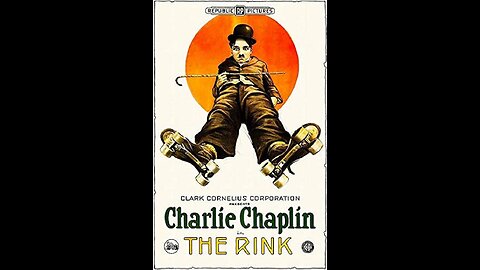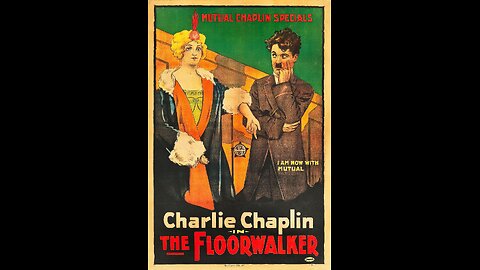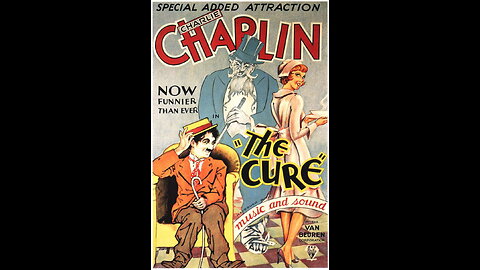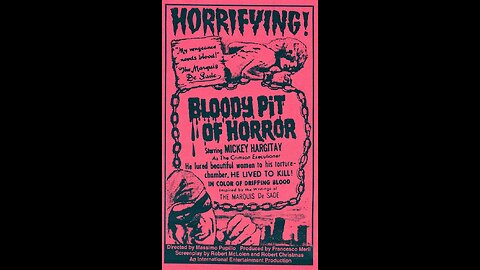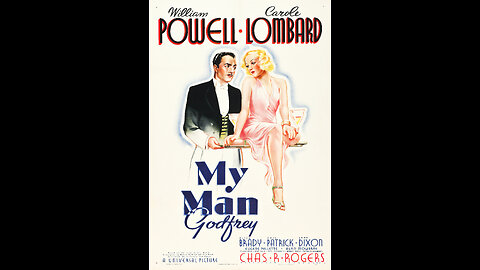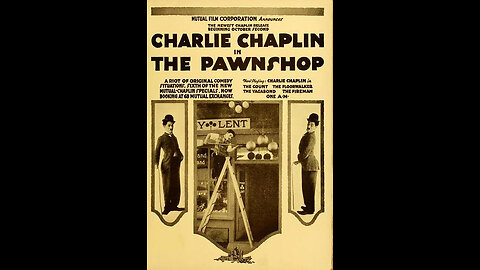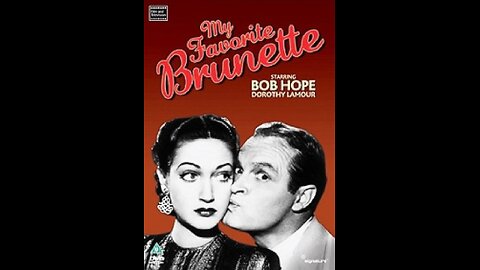
Feature Film Classics
22 videos
Updated 1 year ago
Immerse yourself in the golden era of cinema with our "Feature Film Classics" playlist, featuring a handpicked selection of classic films. From riveting dramas to pioneering comedies and groundbreaking noir, these films represent the pinnacle of early filmmaking. Each piece in this collection not only showcases the artistic and narrative brilliance of its time but also offers a window into the rich tapestry of cinematic history. Ideal for film aficionados and those yearning for a taste of classic Hollywood, this playlist is your gateway to experiencing the foundational works that shaped the world of cinema. Sit back, relax, and enjoy these enduring classics.
-
My Favorite Brunette (1947)
 Dream In Pictures"My Favorite Brunette" is a 1947 American romantic comedy film directed by Elliott Nugent. This film noir parody stars Bob Hope as Ronnie Jackson, a San Francisco baby photographer who dreams of becoming a private detective like his office neighbor Sam McCloud, played by Alan Ladd. The plot takes a comedic turn when Ronnie is mistaken for a real detective by the beautiful but distressed Baroness Carlotta Montay, portrayed by Dorothy Lamour. The story unfolds with a mix of intrigue and humor as Ronnie, eager to impress the baroness, finds himself entangled in a web of espionage and kidnapping. The film cleverly juxtaposes elements of mystery and suspense with slapstick comedy and witty dialogue, providing a lighthearted spoof of the typically dark film noir genre. "My Favorite Brunette" is celebrated for its clever writing, engaging performances, and its successful blend of genres. With supporting roles filled by notable actors such as Peter Lorre and Lon Chaney Jr., the film offers a delightful mix of humor, romance, and adventure, making it a beloved classic in the comedy genre.67 views
Dream In Pictures"My Favorite Brunette" is a 1947 American romantic comedy film directed by Elliott Nugent. This film noir parody stars Bob Hope as Ronnie Jackson, a San Francisco baby photographer who dreams of becoming a private detective like his office neighbor Sam McCloud, played by Alan Ladd. The plot takes a comedic turn when Ronnie is mistaken for a real detective by the beautiful but distressed Baroness Carlotta Montay, portrayed by Dorothy Lamour. The story unfolds with a mix of intrigue and humor as Ronnie, eager to impress the baroness, finds himself entangled in a web of espionage and kidnapping. The film cleverly juxtaposes elements of mystery and suspense with slapstick comedy and witty dialogue, providing a lighthearted spoof of the typically dark film noir genre. "My Favorite Brunette" is celebrated for its clever writing, engaging performances, and its successful blend of genres. With supporting roles filled by notable actors such as Peter Lorre and Lon Chaney Jr., the film offers a delightful mix of humor, romance, and adventure, making it a beloved classic in the comedy genre.67 views -
Charlie Chaplin's "The Rink" (1916)
 Dream In Pictures"The Rink," released in 1916, is a silent comedy film starring Charlie Chaplin, one of his more popular movies from the Mutual Film Corporation period. In this film, Chaplin plays a bumbling waiter who eventually finds himself at a roller-skating rink where his skill and grace on wheels shine through his otherwise clumsy persona. The film is celebrated for showcasing Chaplin's incredible physical comedy and timing, particularly in the roller-skating sequences which highlight his agility and balletic control. "The Rink" is one of the first films to feature comedic scenes set in a roller-skating rink, making it a pioneering piece in the genre of slapstick comedy. As Chaplin’s character switches between his duties as a waiter and his adventures at the rink, the film offers a series of humorous escapades that include flirtations, rivalries, and a chaotic finale that is typical of Chaplin’s work. "The Rink" stands out for its clever use of physical space and the comedian's iconic physical humor, making it a memorable example of early cinema comedy.40 views
Dream In Pictures"The Rink," released in 1916, is a silent comedy film starring Charlie Chaplin, one of his more popular movies from the Mutual Film Corporation period. In this film, Chaplin plays a bumbling waiter who eventually finds himself at a roller-skating rink where his skill and grace on wheels shine through his otherwise clumsy persona. The film is celebrated for showcasing Chaplin's incredible physical comedy and timing, particularly in the roller-skating sequences which highlight his agility and balletic control. "The Rink" is one of the first films to feature comedic scenes set in a roller-skating rink, making it a pioneering piece in the genre of slapstick comedy. As Chaplin’s character switches between his duties as a waiter and his adventures at the rink, the film offers a series of humorous escapades that include flirtations, rivalries, and a chaotic finale that is typical of Chaplin’s work. "The Rink" stands out for its clever use of physical space and the comedian's iconic physical humor, making it a memorable example of early cinema comedy.40 views -
Lady Frankenstein (1971)
 Dream In Pictures"Lady Frankenstein" is a 1971 horror film directed by Mel Welles, co-produced by Italy and the United States. This gothic tale acts as a unique spin-off from the classic Mary Shelley story, focusing on Tania Frankenstein, the daughter of the infamous scientist Victor Frankenstein. Played by Rosalba Neri (credited as Sara Bay), Tania is not just a mere observer of her father’s experiments; she is a brilliant surgeon who takes an active role in his macabre endeavors. After her father's death, Tania becomes determined to continue his work, pushing the boundaries of science and ethics even further. The plot unfolds as she attempts to create her own creature with enhancements aimed at correcting the flaws she saw in her father's creation. The film blends elements of horror with questions of identity, power, and the consequences of unbridled ambition. "Lady Frankenstein" is characterized by its atmospheric setting, period costumes, and a narrative that delves into themes of creation and creator, adding layers of complexity to the traditional Frankenstein story. The film has been noted for its daring approach to gender roles within the horror genre, making it a distinctive and provocative entry in the canon of Frankenstein films.48 views
Dream In Pictures"Lady Frankenstein" is a 1971 horror film directed by Mel Welles, co-produced by Italy and the United States. This gothic tale acts as a unique spin-off from the classic Mary Shelley story, focusing on Tania Frankenstein, the daughter of the infamous scientist Victor Frankenstein. Played by Rosalba Neri (credited as Sara Bay), Tania is not just a mere observer of her father’s experiments; she is a brilliant surgeon who takes an active role in his macabre endeavors. After her father's death, Tania becomes determined to continue his work, pushing the boundaries of science and ethics even further. The plot unfolds as she attempts to create her own creature with enhancements aimed at correcting the flaws she saw in her father's creation. The film blends elements of horror with questions of identity, power, and the consequences of unbridled ambition. "Lady Frankenstein" is characterized by its atmospheric setting, period costumes, and a narrative that delves into themes of creation and creator, adding layers of complexity to the traditional Frankenstein story. The film has been noted for its daring approach to gender roles within the horror genre, making it a distinctive and provocative entry in the canon of Frankenstein films.48 views -
Charlie Chaplin's "The Floorwalker" (1916)
 Dream In Pictures"The Floorwalker" is a 1916 silent film that marks a significant entry in Charlie Chaplin's illustrious career, as it introduced his first mutual comedy film. In this pioneering work, Chaplin plays a tramp who stumbles into a department store and unwittingly becomes embroiled in both comedic chaos and a case of managerial embezzlement. The film is notable for its inventive use of the department store setting, which provides a new environment for Chaplin's signature slapstick comedy. This includes the innovative use of escalators which Chaplin turns into a stage for his physical comedy genius. "The Floorwalker" also introduces elements of mistaken identity and a chase sequence that would become staples in many of Chaplin’s later films. As the Tramp character navigates through various store departments, his interactions with the store manager and a mirror sequence are particularly memorable, offering a blend of humor and critique of modern consumer culture. "The Floorwalker" is celebrated for its clever and seamless blend of physical comedy and social commentary, showcasing Chaplin's burgeoning talent in film comedy and narrative construction.46 views
Dream In Pictures"The Floorwalker" is a 1916 silent film that marks a significant entry in Charlie Chaplin's illustrious career, as it introduced his first mutual comedy film. In this pioneering work, Chaplin plays a tramp who stumbles into a department store and unwittingly becomes embroiled in both comedic chaos and a case of managerial embezzlement. The film is notable for its inventive use of the department store setting, which provides a new environment for Chaplin's signature slapstick comedy. This includes the innovative use of escalators which Chaplin turns into a stage for his physical comedy genius. "The Floorwalker" also introduces elements of mistaken identity and a chase sequence that would become staples in many of Chaplin’s later films. As the Tramp character navigates through various store departments, his interactions with the store manager and a mirror sequence are particularly memorable, offering a blend of humor and critique of modern consumer culture. "The Floorwalker" is celebrated for its clever and seamless blend of physical comedy and social commentary, showcasing Chaplin's burgeoning talent in film comedy and narrative construction.46 views -
Charlie Chaplin's "The Cure" (1917)
 Dream In Pictures"The Cure" is a 1917 silent film comedy starring Charlie Chaplin, who also directed the short. In this engaging feature, Chaplin plays an inebriate who checks into a health spa to take a cure for his alcoholism, but instead brings chaos to the orderly establishment with his antics. Chaplin's character, with his characteristic blend of slapstick and pathos, disrupts the spa's tranquil atmosphere through a series of comic misadventures. Notably, his interactions around a revolving door and his mishandling of a mineral water wheel become central comedic set pieces. "The Cure" showcases Chaplin's skill in physical comedy, as he masterfully turns simple scenarios into elaborate comedic sequences that resonate with his audience. The film is a significant work in Chaplin’s filmography, highlighting his evolving artistry in the silent film era. "The Cure" is not just a sequence of gags but a well-crafted narrative that cleverly critiques and satirizes the culture of health spas and the idea of easy fixes for complex problems. It remains a favorite among Chaplin aficionados and film historians for its innovative comedy and enduring charm.41 views
Dream In Pictures"The Cure" is a 1917 silent film comedy starring Charlie Chaplin, who also directed the short. In this engaging feature, Chaplin plays an inebriate who checks into a health spa to take a cure for his alcoholism, but instead brings chaos to the orderly establishment with his antics. Chaplin's character, with his characteristic blend of slapstick and pathos, disrupts the spa's tranquil atmosphere through a series of comic misadventures. Notably, his interactions around a revolving door and his mishandling of a mineral water wheel become central comedic set pieces. "The Cure" showcases Chaplin's skill in physical comedy, as he masterfully turns simple scenarios into elaborate comedic sequences that resonate with his audience. The film is a significant work in Chaplin’s filmography, highlighting his evolving artistry in the silent film era. "The Cure" is not just a sequence of gags but a well-crafted narrative that cleverly critiques and satirizes the culture of health spas and the idea of easy fixes for complex problems. It remains a favorite among Chaplin aficionados and film historians for its innovative comedy and enduring charm.41 views -
The Lost World (1925)
 Dream In Pictures"The Lost World" is a 1925 silent adventure film that is pivotal in the history of cinema for its pioneering special effects. Directed by Harry O. Hoyt and based on Sir Arthur Conan Doyle's novel of the same name, the film features the groundbreaking stop-motion animation work of Willis O'Brien, who would later work on "King Kong." The story follows Professor Challenger, played by Wallace Beery, who leads an expedition from London to a plateau in the Amazon basin in South America where prehistoric creatures, including dinosaurs, still roam. The team consists of a diverse group of characters, each with their own motivations for joining the journey, from seeking adventure to capturing photographic evidence of their discoveries. Upon arriving, they encounter an array of dinosaurs and other ancient beasts, leading to thrilling encounters and narrow escapes. The special effects used to bring the dinosaurs to life were revolutionary at the time, setting a new standard for film and influencing future generations of visual effects artists. "The Lost World" is not only notable for its technical achievements but also as an exciting adventure tale that captures the imagination and wonder of its audience. It remains a landmark film in the science fiction and fantasy genres, celebrated for its ambitious scope and its early contribution to the genre of creature features.52 views
Dream In Pictures"The Lost World" is a 1925 silent adventure film that is pivotal in the history of cinema for its pioneering special effects. Directed by Harry O. Hoyt and based on Sir Arthur Conan Doyle's novel of the same name, the film features the groundbreaking stop-motion animation work of Willis O'Brien, who would later work on "King Kong." The story follows Professor Challenger, played by Wallace Beery, who leads an expedition from London to a plateau in the Amazon basin in South America where prehistoric creatures, including dinosaurs, still roam. The team consists of a diverse group of characters, each with their own motivations for joining the journey, from seeking adventure to capturing photographic evidence of their discoveries. Upon arriving, they encounter an array of dinosaurs and other ancient beasts, leading to thrilling encounters and narrow escapes. The special effects used to bring the dinosaurs to life were revolutionary at the time, setting a new standard for film and influencing future generations of visual effects artists. "The Lost World" is not only notable for its technical achievements but also as an exciting adventure tale that captures the imagination and wonder of its audience. It remains a landmark film in the science fiction and fantasy genres, celebrated for its ambitious scope and its early contribution to the genre of creature features.52 views -
The Stranger (1946)
 Dream In Pictures"The Stranger" is a 1946 American film noir directed by Orson Welles, who also stars in the film alongside Edward G. Robinson and Loretta Young. This gripping thriller is notable for being one of the first films released after World War II to depict Nazi war crimes, presenting a bold and dark narrative that explores themes of justice and identity. In the film, Welles portrays Franz Kindler, a former Nazi architect of the Holocaust who has erased all traces of his identity and taken on a new life as Charles Rankin, a respected professor in a quaint Connecticut town. Edward G. Robinson delivers a compelling performance as Mr. Wilson, a war crimes investigator from the United Nations who tracks down Kindler. Loretta Young plays Mary, Rankin's unsuspecting wife, caught in the escalating tension between her husband and his pursuer. The plot thickens as Wilson closes in, and Kindler’s facade begins to crumble, leading to a suspenseful and dramatic climax. Welles' direction is masterful, weaving tension and moral complexity into a narrative that maintains a tight pace and atmospheric depth. "The Stranger" is celebrated not only for its historical significance but also for its cinematographic techniques, including striking use of shadows and lighting typical of film noir, enhancing the psychological drama and the moral quandaries it presents. The film remains a critical piece in the exploration of post-war cinema and the psychological portrait of a Nazi fugitive hiding in plain sight.46 views
Dream In Pictures"The Stranger" is a 1946 American film noir directed by Orson Welles, who also stars in the film alongside Edward G. Robinson and Loretta Young. This gripping thriller is notable for being one of the first films released after World War II to depict Nazi war crimes, presenting a bold and dark narrative that explores themes of justice and identity. In the film, Welles portrays Franz Kindler, a former Nazi architect of the Holocaust who has erased all traces of his identity and taken on a new life as Charles Rankin, a respected professor in a quaint Connecticut town. Edward G. Robinson delivers a compelling performance as Mr. Wilson, a war crimes investigator from the United Nations who tracks down Kindler. Loretta Young plays Mary, Rankin's unsuspecting wife, caught in the escalating tension between her husband and his pursuer. The plot thickens as Wilson closes in, and Kindler’s facade begins to crumble, leading to a suspenseful and dramatic climax. Welles' direction is masterful, weaving tension and moral complexity into a narrative that maintains a tight pace and atmospheric depth. "The Stranger" is celebrated not only for its historical significance but also for its cinematographic techniques, including striking use of shadows and lighting typical of film noir, enhancing the psychological drama and the moral quandaries it presents. The film remains a critical piece in the exploration of post-war cinema and the psychological portrait of a Nazi fugitive hiding in plain sight.46 views -
Bloody Pit of Horror (1965)
 Dream In Pictures"Bloody Pit of Horror" is a 1965 Italian horror film directed by Massimo Pupillo, known for its vivid colors and lurid content that epitomizes the exploitation horror genre of the mid-20th century. The film stars Mickey Hargitay as Travis Anderson, a former actor who now resides in a secluded castle previously owned by a sadistic 16th-century executioner, the Crimson Executioner. The plot unfolds as a group of photographers and models discover Anderson's castle and decide it's the perfect backdrop for their photo shoot. However, the castle's horrific past quickly bleeds into the present when Anderson, driven to madness and believing himself to be the reincarnation of the Crimson Executioner, turns on the visitors in a series of elaborate and gruesome tortures. "Bloody Pit of Horror" is characterized by its theatricality, over-the-top gore, and a distinctly macabre aesthetic. With its campy execution and vivid technicolor scenes, the film has gained a cult following, appreciated both for its so-bad-it's-good appeal and its place as a quintessential example of the horror exploitation wave of the 1960s. The film's blend of historical intrigue, psychological unraveling, and unabashed splatter makes it a unique fixture in the horror genre, offering a grotesque yet mesmerizing viewing experience.46 views
Dream In Pictures"Bloody Pit of Horror" is a 1965 Italian horror film directed by Massimo Pupillo, known for its vivid colors and lurid content that epitomizes the exploitation horror genre of the mid-20th century. The film stars Mickey Hargitay as Travis Anderson, a former actor who now resides in a secluded castle previously owned by a sadistic 16th-century executioner, the Crimson Executioner. The plot unfolds as a group of photographers and models discover Anderson's castle and decide it's the perfect backdrop for their photo shoot. However, the castle's horrific past quickly bleeds into the present when Anderson, driven to madness and believing himself to be the reincarnation of the Crimson Executioner, turns on the visitors in a series of elaborate and gruesome tortures. "Bloody Pit of Horror" is characterized by its theatricality, over-the-top gore, and a distinctly macabre aesthetic. With its campy execution and vivid technicolor scenes, the film has gained a cult following, appreciated both for its so-bad-it's-good appeal and its place as a quintessential example of the horror exploitation wave of the 1960s. The film's blend of historical intrigue, psychological unraveling, and unabashed splatter makes it a unique fixture in the horror genre, offering a grotesque yet mesmerizing viewing experience.46 views -
My Man Godfrey (1936)
 Dream In Pictures"My Man Godfrey" is a 1936 screwball comedy directed by Gregory La Cava and one of the defining films of the genre during Hollywood's Golden Age. The film stars William Powell as Godfrey, a suave and resourceful man who is discovered living in a city dump by a wealthy socialite, Irene Bullock, played by Carole Lombard. After winning a high-society scavenger hunt by presenting him as the "Forgotten Man," Irene impulsively hires Godfrey as the family butler. Set against the backdrop of the Great Depression, "My Man Godfrey" explores themes of class disparity and the foibles of the rich through sharp wit and a socially conscious narrative. As Godfrey becomes an indispensable part of the Bullock household, his clever manipulations expose the absurdities of the wealthy and ultimately lead to profound transformations within the family. The film is celebrated not only for its humorous script and dynamic performances but also for its deeper commentary on societal values and economic disparity. "My Man Godfrey" is a timeless classic that remains a poignant satire as well as a delightful and enduring piece of cinematic artistry. Its legacy includes multiple Academy Award nominations and a lasting influence on the genre of romantic comedies and societal satires.37 views
Dream In Pictures"My Man Godfrey" is a 1936 screwball comedy directed by Gregory La Cava and one of the defining films of the genre during Hollywood's Golden Age. The film stars William Powell as Godfrey, a suave and resourceful man who is discovered living in a city dump by a wealthy socialite, Irene Bullock, played by Carole Lombard. After winning a high-society scavenger hunt by presenting him as the "Forgotten Man," Irene impulsively hires Godfrey as the family butler. Set against the backdrop of the Great Depression, "My Man Godfrey" explores themes of class disparity and the foibles of the rich through sharp wit and a socially conscious narrative. As Godfrey becomes an indispensable part of the Bullock household, his clever manipulations expose the absurdities of the wealthy and ultimately lead to profound transformations within the family. The film is celebrated not only for its humorous script and dynamic performances but also for its deeper commentary on societal values and economic disparity. "My Man Godfrey" is a timeless classic that remains a poignant satire as well as a delightful and enduring piece of cinematic artistry. Its legacy includes multiple Academy Award nominations and a lasting influence on the genre of romantic comedies and societal satires.37 views -
Charlie Chaplin's "The Pawnshop" (1916)
 Dream In PicturesStep into the uproarious world of "The Pawnshop," a 1916 silent film comedy classic directed by and starring the inimitable Charlie Chaplin. In this delightful short, Chaplin portrays an eccentric pawnshop assistant whose antics and clumsy misadventures turn everyday tasks into comedic gold. From battling with co-workers to creatively mishandling merchandise, Chaplin's character brings a whirlwind of chaos and laughter to the unassuming pawnshop setting. Each scene is meticulously crafted, showcasing Chaplin's genius for physical comedy and timing, as he turns simple interactions into elaborate comedic sequences. Whether it's a showdown with a ticking alarm clock or a playful skirmish with his fellow assistant, Chaplin's antics are both timeless and universally appealing. "The Pawnshop" is a testament to Charlie Chaplin’s enduring charm and comedic brilliance, making it a treasured piece of cinematic history. This film not only entertains but also offers insight into the early days of silent film comedy, making it a must-watch for enthusiasts and newcomers alike who wish to experience the origins of visual humor.51 views
Dream In PicturesStep into the uproarious world of "The Pawnshop," a 1916 silent film comedy classic directed by and starring the inimitable Charlie Chaplin. In this delightful short, Chaplin portrays an eccentric pawnshop assistant whose antics and clumsy misadventures turn everyday tasks into comedic gold. From battling with co-workers to creatively mishandling merchandise, Chaplin's character brings a whirlwind of chaos and laughter to the unassuming pawnshop setting. Each scene is meticulously crafted, showcasing Chaplin's genius for physical comedy and timing, as he turns simple interactions into elaborate comedic sequences. Whether it's a showdown with a ticking alarm clock or a playful skirmish with his fellow assistant, Chaplin's antics are both timeless and universally appealing. "The Pawnshop" is a testament to Charlie Chaplin’s enduring charm and comedic brilliance, making it a treasured piece of cinematic history. This film not only entertains but also offers insight into the early days of silent film comedy, making it a must-watch for enthusiasts and newcomers alike who wish to experience the origins of visual humor.51 views
